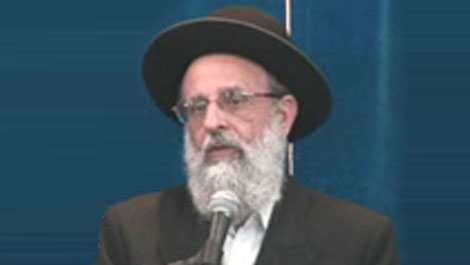Beit Midrash
- Shabbat and Holidays
- Jewish Holidays
- Sukkot
Translated by Hillel Fendel
Zionist Etrogim
The late saintly Rabbi Mordechai Eliyahu served as Chief Sephardic Rabbi of Israel from 1983 to 1993. His student Rabbi Yosef Alnekaveh related that he was once visiting Rav Eliyahu and they were discussing the greatness of the Baba Sali, Rav Yisrael Abuhatzeirah.
"Here, I'll show you something interesting," Rav Eliyahu told his student, and pulled out three thin sticks, asked, "Can you imagine what these are? They are dried-out etrogim that grew in Morocco; the Baba Sali would send me one every year because he felt that they were of the highest quality. But you should know that I never recited a blessing over an etrog that he sent me – because I only recite this [once-a-day] blessing over etrogim of our holy land on which the Land-dependent mitzvot [such as tithes, orlah, etc.] have been observed. Know that there is nothing like the sanctity of the Land of Israel."
Zionist Etrogim
The late saintly Rabbi Mordechai Eliyahu served as Chief Sephardic Rabbi of Israel from 1983 to 1993. His student Rabbi Yosef Alnekaveh related that he was once visiting Rav Eliyahu and they were discussing the greatness of the Baba Sali, Rav Yisrael Abuhatzeirah.
"Here, I'll show you something interesting," Rav Eliyahu told his student, and pulled out three thin sticks, asked, "Can you imagine what these are? They are dried-out etrogim that grew in Morocco; the Baba Sali would send me one every year because he felt that they were of the highest quality. But you should know that I never recited a blessing over an etrog that he sent me – because I only recite this [once-a-day] blessing over etrogim of our holy land on which the Land-dependent mitzvot [such as tithes, orlah, etc.] have been observed. Know that there is nothing like the sanctity of the Land of Israel."
Rav Eliyahu added, "I told the Baba Sali myself that I recite the blessing only over an etrog from Israel, and yet, he still used to send me a Moroccan etrog every year. Nothing measures up to Land of Israel etrogim!" He then said with a smile, "There are those in America who say that the Moroccan etrogim are the most beautiful, but that's because they view the etrogim from Israel as Tzioneshe etrogim.'"And he finished by saying, "There is nothing like the etrogim of our holy Land."
Throughout the conversation his immense love for out holy Land was evident, and how his tumultuous soul would overflow with great affection for the Land.
The Pasul [Disqualified] Etrog
Rabbi Alnekaveh told a story he heard once from an etrog-seller who used to bring Rav Eliyahu etrogim to check: "It is well-known that Rab Eliyahu could look at an etrog for mere seconds and immediately discern its advantages and defects. He would often check tens and hundreds of etrogim, ruling quickly which were kosher and which were mehudar [particularly beautiful], and which were not a good idea to choose. He would hardly ever say that a given etrog was pasul [totally disqualified], but would rather say, "Take a different one." And if they would bring him an etrog that he had checked a day or a few days earlier, he would say so: "I saw this etrog already, and I ruled then that it was such-and-such." Only once did I ever hear him actually disqualify an etrog. It happened as follows:
"A man came in with a beautiful etrog and proudly said that it had cost him one thousand dollars! The Rav looked for a moment at the etrog – truly a beautiful one – and asked, "If it is pasul, will you get your money back?" The man said that he would, because he had made the sale contingent upon Rav Eliyahu's approval. The Rav then asked, "Tell me, have you already fulfilled another Torah mitzvah for this holiday – namely, buying your wife a special gift to gladden her? That's the mitzvah of You shall rejoice on your holiday!"
The man muttered something in response, and Rav Eliyahu said, "The etrog is pasul!" The man was shocked and said, "How so? What makes it pasul?" The Rav showed him a small hole at the bottom of the etrog, one that had been slightly hidden by the protruding stem. The man was taken aback, to say the least. The Rav continued and said: "You don't have to spend $1,000 for an etrog. It's enough if you spend 100 shekels like everyone else, and use the remainder of the money to gladden your wife on the holiday, as the Torah commands."
"When the man left, we asked the Rav how he had managed, in only a few seconds, to find a disqualifying hole under the stem. He answered that the Hassidim say that "etrog" in Hebrew is an acronym for al tevoeni regel gaavah (Psalms 36,12), which means, "Let not the foot of haughtiness come with me." This etrog came along with haughtiness, so I knew it could not be an acceptable one."
In order to get articles like this delivered straight to your inbox every week, subscribe to the Israel National Torah newsletter here.
In order to get articles like this delivered straight to your inbox every week, subscribe to the Israel National Torah newsletter here.

A Time for Everything ... Including Contradictions
Various Rabbis | Sunday, 11 Tishrei 5768

The Secret Essence of Hoshana Rabba
Rabbi Ari Shvat | Tishrei 21 5782

Tree Tastes Like the Fruit
Rabbi Ari Shvat | Tishrei 5786




















